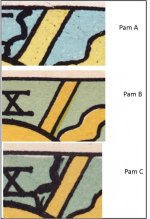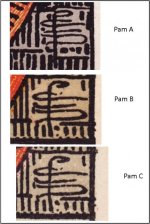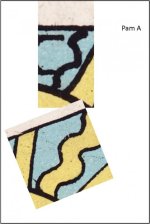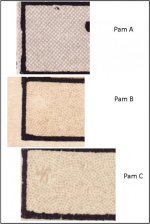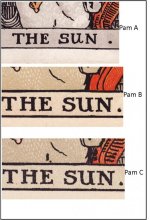truelighth
Warning: VERY long post :-D
I have recently had a lot of conversations with someone who is doing research about the early Rider Waite editions and most specifically the line art and the differences. This has made me revisit my own old RWS decks and the articles written about the early Rider Waite editions.
In the thread about the Roses&Lilies deck with the letter from Rider that was sold on Ebay, there were a lot of discussions and theories posed. Also by me. I stated that I consider the Roses&Lilies deck to be the first version, but could not really point out why.
Having re-read and revisited the materials that I do have, among which the article from Pietro Alligo about the early RWS editions, the book from Frank Jensen and also the post from OnePotato on the subject, I came to some thoughts and realisations, I would like to share.
It mostly concerns the article of Pietro Alligo and why in my opinion the theory he poses that the Pam B/C decks were printed first, is faulty. I do want to state I very much appreciate and honor the work he has done on the early Rider decks.
Yet, the theory always bothered me. In the first instance, because the line art is so much inferior on the Pam B and C decks, compared to the Pam-A. And I don’t believe Pixie would have delivered sub-standard work. Looking at her other artwork, which is gorgeous, the faces and line art on the Pam-A fit. As where the art on the Pam B and C decks, does not.
In the article of Pietro Alligo, he states that one of the reasons he believes the Pam B/C deck is the original deck, is because so many adjustments have been made. The first adjustment he mentions if that of the Child’s hand on the Sun card. It is indeed true that the hand on the Sun card in the B/C deck is strange. The colouring is wrong, the proportions are not in line with the rest of the body and the banner is also misaligned. Pietro states that he believes that Waite himself probably asked for this modification, which was then adjusted by the copiers. This may be true, but I that if Waite indeed overlooked the process, he would approve of such a crude modification.
The next adjustment and of course the subject of lot of discussion, is the Ray on the Sun card. Which does appear on the Pam-A, but not on the Pam-B and in a different form on the Pam-C. Pietro Alligo proposes that originally there was no Ray, resulting in the Pam-B. However, due to a accident with the black printing stone, the stone was cracked. Causing the crack to appear, extending all the way to the eyebrow of the Sun. The printers erased most of the crack with pumice in two stages, first most of the Ray/crack. Later also by removing the little line left at the eyebrow. There are decks out there who support this part. My deck has the little line. The C deck that Frank Jensen used in his book, does not.
In the article, the theory is posed that since it was difficult to correct the crack, they woud have left the ray, since it would not really unbalance the drawing. And that future versions (being the Roses&Lilies deck and the Pam-A) have copied this line. However, I can’t believe that if Waite was really overlooking the process and being very precise about the images, like with the Child’s hand, he would approve of such an extra line suddenly appearing. This to me seems odd. It also doesn’t explain why the printers suddenly added a lot of extra lines to the banner on the Sun card on the C version. The B version has virtually no lines on the banner, only on top and there are also dots missing on one of the sunflowers. The C version, apart from the Ray, also suddenly has the lines on the banner and the dots on the sunflower. It seems more plausible to me that the initial copiers had forgotten the lines, dots and the ray in the first printings (Pam-B) and they were later added to adjust the cards. If you look at the Pam-B, it actually seems strange only the top of the banner has the extra lines and the rest of the banner is lacking these.
In the discussion thread I mentioned earlier, Bill Wolf, who knows more about lithography and printing processes then I do, mentions that cracked stones would not behave as described in the article and that any surface scratch could have easily have been fixed in a matter of minutes. Which would not make it nessesary for a whole new printing. Combine this the images of the Sun card that were published in the Occult Review in December 1909 (where the Sun card actually has a wrong number XVIII, but is already showing the much discussed Ray, it makes it clear that this line, was supposed to be on the card all along. Which makes the theory of the cracked stone causing this line less plausible.
Now, the reason for me to write this post/article, is not just to pick apart Pietro Alligo’s article. It is also to share my theory on the early Rider Waite versions.
My theory is that the Roses&Lilies deck was the very first edition, printed in 1909. Due to the inferior quality of the card stock, which made the backs peel off and other problems, Rider decided to re-print on better card stock. I believe Bill Wolf was correct in his assumption that the Rider company probably filled the initial orders by sending out the Roses&Lilies decks, with the letter that the deck could be exchanged once the new edition was printed. The Roses&Lilies deck with the letter from Rider that Tarotwolf won on the auction, is a further indication of this. As is the fact that not many Roses&Lilies decks have survived compared to the crackled back Pam-A. Many were probably destroyed.
In the biography of Waite is written that Waite himself spoke of a second edition printed in 1910 on paper of superior quality. This edition would be the crackled back Pam-A, which indeed also replaced many Roses&Lilies decks. In fact, the card quality of the crackled Pam-A is indeed superior. Also, the forementioned image of the Sun card from article on the Occult Review, shows the line art as is present in both the Roses&Lilies and the crackled back Pam-A. Which to me points that this is the original art.
The line art in both the Pam B and C is different. If you look closely to the art, it is much more sloppy, faces are different. The symbols on the dress of the woman on the 9 of pentacles are added later, as well as many other details. I believe the Pam-B and Pam-C were printed later and that new copiers have copied the images to new plates. Although these copiers have not carefully followed the original line art. Of these two decks, the Pam-B probably came first, followed later by the Pam-C. The line art in both decks is the same, except for the Sun card. And because of the reasons described above (the lines on the banner, dots on the sunflower and the Ray), it seems plausible that the Pam-B was printed first and that these corrections were made for a later print run, resulting in the Pam-C. One question on these do remain, and that is why there are two version of the Pam-C. One version with the extra line at the eyebrow of the Sun and one without.
Conclusion, the Roses&Lilies deck was printed and published first, followed by the crackled back Pam-A. Then later the Pam-B was published for a short time, followed by the Pam-C.
Where the Pam-D comes in this story? I believe this deck was published even later then the Pam-B and Pam-C. The Pam-D seems to be a photographic copy of the Pam-A, but of much less quality. But this just my opinion.
Then lastly, I would like to also pose one more opinion, that is different from what Frank Jensen wrote in his book. He considers the Roses&Lilies deck and the crackled back Pam-A to be the same and calls them Pam-A. However, they are not. Even though they are similar in line art, there are some substantial differences. The backs are different as well as the card stock. But there are also differences in the colours. The colours on the Roses&Lilies seem much more saturated. The crackled back version has more cropped images then the Roses&Lilies. And some images have ever so subtle differences in colouring. On the Roses&Lilies deck, the boots of the man on the 7 of Pentacles are the same colour. On the crackled back the boots are different colours.
I therefore believe that the Roses&Lilies deck and the crackled back Pam-A should be considered different print-runs and editions and also be addressed that way. And maybe even deserve their own categorization, instead of both being referred to as Pam-A.
Anyway, this has become quite a long post. I would appreciate any feedback or thoughts.
One last bit of tidbit for anyone who loves the old Rider decks like I do. Another copy of the Roses&Lilies deck has shown up and is now in the possession of a tarot collector. This means that there are now four known copies of the Roses&Lilies deck.
I have recently had a lot of conversations with someone who is doing research about the early Rider Waite editions and most specifically the line art and the differences. This has made me revisit my own old RWS decks and the articles written about the early Rider Waite editions.
In the thread about the Roses&Lilies deck with the letter from Rider that was sold on Ebay, there were a lot of discussions and theories posed. Also by me. I stated that I consider the Roses&Lilies deck to be the first version, but could not really point out why.
Having re-read and revisited the materials that I do have, among which the article from Pietro Alligo about the early RWS editions, the book from Frank Jensen and also the post from OnePotato on the subject, I came to some thoughts and realisations, I would like to share.
It mostly concerns the article of Pietro Alligo and why in my opinion the theory he poses that the Pam B/C decks were printed first, is faulty. I do want to state I very much appreciate and honor the work he has done on the early Rider decks.
Yet, the theory always bothered me. In the first instance, because the line art is so much inferior on the Pam B and C decks, compared to the Pam-A. And I don’t believe Pixie would have delivered sub-standard work. Looking at her other artwork, which is gorgeous, the faces and line art on the Pam-A fit. As where the art on the Pam B and C decks, does not.
In the article of Pietro Alligo, he states that one of the reasons he believes the Pam B/C deck is the original deck, is because so many adjustments have been made. The first adjustment he mentions if that of the Child’s hand on the Sun card. It is indeed true that the hand on the Sun card in the B/C deck is strange. The colouring is wrong, the proportions are not in line with the rest of the body and the banner is also misaligned. Pietro states that he believes that Waite himself probably asked for this modification, which was then adjusted by the copiers. This may be true, but I that if Waite indeed overlooked the process, he would approve of such a crude modification.
The next adjustment and of course the subject of lot of discussion, is the Ray on the Sun card. Which does appear on the Pam-A, but not on the Pam-B and in a different form on the Pam-C. Pietro Alligo proposes that originally there was no Ray, resulting in the Pam-B. However, due to a accident with the black printing stone, the stone was cracked. Causing the crack to appear, extending all the way to the eyebrow of the Sun. The printers erased most of the crack with pumice in two stages, first most of the Ray/crack. Later also by removing the little line left at the eyebrow. There are decks out there who support this part. My deck has the little line. The C deck that Frank Jensen used in his book, does not.
In the article, the theory is posed that since it was difficult to correct the crack, they woud have left the ray, since it would not really unbalance the drawing. And that future versions (being the Roses&Lilies deck and the Pam-A) have copied this line. However, I can’t believe that if Waite was really overlooking the process and being very precise about the images, like with the Child’s hand, he would approve of such an extra line suddenly appearing. This to me seems odd. It also doesn’t explain why the printers suddenly added a lot of extra lines to the banner on the Sun card on the C version. The B version has virtually no lines on the banner, only on top and there are also dots missing on one of the sunflowers. The C version, apart from the Ray, also suddenly has the lines on the banner and the dots on the sunflower. It seems more plausible to me that the initial copiers had forgotten the lines, dots and the ray in the first printings (Pam-B) and they were later added to adjust the cards. If you look at the Pam-B, it actually seems strange only the top of the banner has the extra lines and the rest of the banner is lacking these.
In the discussion thread I mentioned earlier, Bill Wolf, who knows more about lithography and printing processes then I do, mentions that cracked stones would not behave as described in the article and that any surface scratch could have easily have been fixed in a matter of minutes. Which would not make it nessesary for a whole new printing. Combine this the images of the Sun card that were published in the Occult Review in December 1909 (where the Sun card actually has a wrong number XVIII, but is already showing the much discussed Ray, it makes it clear that this line, was supposed to be on the card all along. Which makes the theory of the cracked stone causing this line less plausible.
Now, the reason for me to write this post/article, is not just to pick apart Pietro Alligo’s article. It is also to share my theory on the early Rider Waite versions.
My theory is that the Roses&Lilies deck was the very first edition, printed in 1909. Due to the inferior quality of the card stock, which made the backs peel off and other problems, Rider decided to re-print on better card stock. I believe Bill Wolf was correct in his assumption that the Rider company probably filled the initial orders by sending out the Roses&Lilies decks, with the letter that the deck could be exchanged once the new edition was printed. The Roses&Lilies deck with the letter from Rider that Tarotwolf won on the auction, is a further indication of this. As is the fact that not many Roses&Lilies decks have survived compared to the crackled back Pam-A. Many were probably destroyed.
In the biography of Waite is written that Waite himself spoke of a second edition printed in 1910 on paper of superior quality. This edition would be the crackled back Pam-A, which indeed also replaced many Roses&Lilies decks. In fact, the card quality of the crackled Pam-A is indeed superior. Also, the forementioned image of the Sun card from article on the Occult Review, shows the line art as is present in both the Roses&Lilies and the crackled back Pam-A. Which to me points that this is the original art.
The line art in both the Pam B and C is different. If you look closely to the art, it is much more sloppy, faces are different. The symbols on the dress of the woman on the 9 of pentacles are added later, as well as many other details. I believe the Pam-B and Pam-C were printed later and that new copiers have copied the images to new plates. Although these copiers have not carefully followed the original line art. Of these two decks, the Pam-B probably came first, followed later by the Pam-C. The line art in both decks is the same, except for the Sun card. And because of the reasons described above (the lines on the banner, dots on the sunflower and the Ray), it seems plausible that the Pam-B was printed first and that these corrections were made for a later print run, resulting in the Pam-C. One question on these do remain, and that is why there are two version of the Pam-C. One version with the extra line at the eyebrow of the Sun and one without.
Conclusion, the Roses&Lilies deck was printed and published first, followed by the crackled back Pam-A. Then later the Pam-B was published for a short time, followed by the Pam-C.
Where the Pam-D comes in this story? I believe this deck was published even later then the Pam-B and Pam-C. The Pam-D seems to be a photographic copy of the Pam-A, but of much less quality. But this just my opinion.
Then lastly, I would like to also pose one more opinion, that is different from what Frank Jensen wrote in his book. He considers the Roses&Lilies deck and the crackled back Pam-A to be the same and calls them Pam-A. However, they are not. Even though they are similar in line art, there are some substantial differences. The backs are different as well as the card stock. But there are also differences in the colours. The colours on the Roses&Lilies seem much more saturated. The crackled back version has more cropped images then the Roses&Lilies. And some images have ever so subtle differences in colouring. On the Roses&Lilies deck, the boots of the man on the 7 of Pentacles are the same colour. On the crackled back the boots are different colours.
I therefore believe that the Roses&Lilies deck and the crackled back Pam-A should be considered different print-runs and editions and also be addressed that way. And maybe even deserve their own categorization, instead of both being referred to as Pam-A.
Anyway, this has become quite a long post. I would appreciate any feedback or thoughts.
One last bit of tidbit for anyone who loves the old Rider decks like I do. Another copy of the Roses&Lilies deck has shown up and is now in the possession of a tarot collector. This means that there are now four known copies of the Roses&Lilies deck.

 .
.
